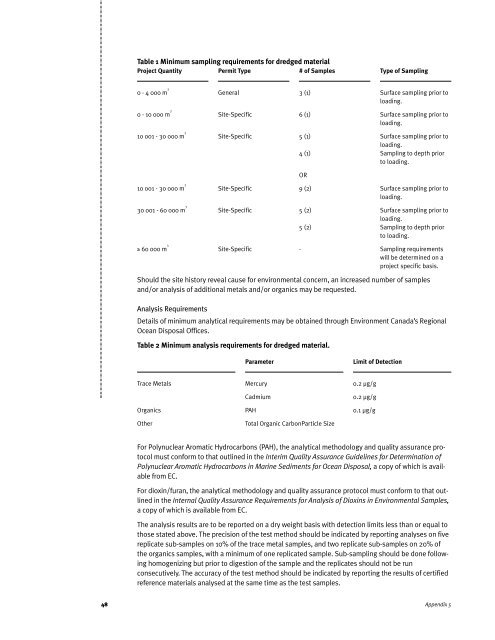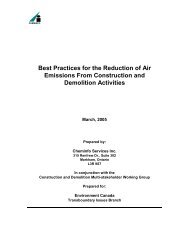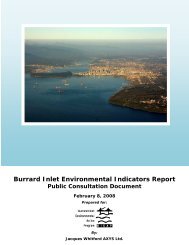Dredge Management Guidelines - the BIEAP and FREMP Website
Dredge Management Guidelines - the BIEAP and FREMP Website
Dredge Management Guidelines - the BIEAP and FREMP Website
Create successful ePaper yourself
Turn your PDF publications into a flip-book with our unique Google optimized e-Paper software.
Table 1 Minimum sampling requirements for dredged material<br />
Project Quantity<br />
Permit Type<br />
# of Samples<br />
0 - 4 000 m 3<br />
0 - 10 000 m 3<br />
10 001 - 30 000 m 3<br />
10 001 - 30 000 m 3<br />
30 001 - 60 000 m 3<br />
≥ 60 000 m 3<br />
Should <strong>the</strong> site history reveal cause for environmental concern, an increased number of samples<br />
<strong>and</strong>/or analysis of additional metals <strong>and</strong>/or organics may be requested.<br />
Analysis Requirements<br />
Details of minimum analytical requirements may be obtained through Environment Canada’s Regional<br />
Ocean Disposal Offices.<br />
Table 2 Minimum analysis requirements for dredged material.<br />
Trace Metals<br />
Organics<br />
O<strong>the</strong>r<br />
General<br />
Site-Specific<br />
Site-Specific<br />
Site-Specific<br />
Site-Specific<br />
Site-Specific<br />
Parameter<br />
Mercury<br />
Cadmium<br />
PAH<br />
For Polynuclear Aromatic Hydrocarbons (PAH), <strong>the</strong> analytical methodology <strong>and</strong> quality assurance protocol<br />
must conform to that outlined in <strong>the</strong> Interim Quality Assurance <strong>Guidelines</strong> for Determination of<br />
Polynuclear Aromatic Hydrocarbons in Marine Sediments for Ocean Disposal, a copy of which is available<br />
from EC.<br />
For dioxin/furan, <strong>the</strong> analytical methodology <strong>and</strong> quality assurance protocol must conform to that outlined<br />
in <strong>the</strong> Internal Quality Assurance Requirements for Analysis of Dioxins in Environmental Samples,<br />
a copy of which is available from EC.<br />
The analysis results are to be reported on a dry weight basis with detection limits less than or equal to<br />
those stated above. The precision of <strong>the</strong> test method should be indicated by reporting analyses on five<br />
replicate sub-samples on 10% of <strong>the</strong> trace metal samples, <strong>and</strong> two replicate sub-samples on 20% of<br />
<strong>the</strong> organics samples, with a minimum of one replicated sample. Sub-sampling should be done following<br />
homogenizing but prior to digestion of <strong>the</strong> sample <strong>and</strong> <strong>the</strong> replicates should not be run<br />
consecutively. The accuracy of <strong>the</strong> test method should be indicated by reporting <strong>the</strong> results of certified<br />
reference materials analysed at <strong>the</strong> same time as <strong>the</strong> test samples.<br />
48 Appendix 5<br />
3 (1)<br />
6 (1)<br />
5 (1)<br />
4 (1)<br />
OR<br />
9 (2)<br />
5 (2)<br />
5 (2)<br />
Total Organic CarbonParticle Size<br />
-<br />
Limit of Detection<br />
0.2 µg/g<br />
0.2 µg/g<br />
0.1 µg/g<br />
Type of Sampling<br />
Surface sampling prior to<br />
loading.<br />
Surface sampling prior to<br />
loading.<br />
Surface sampling prior to<br />
loading.<br />
Sampling to depth prior<br />
to loading.<br />
Surface sampling prior to<br />
loading.<br />
Surface sampling prior to<br />
loading.<br />
Sampling to depth prior<br />
to loading.<br />
Sampling requirements<br />
will be determined on a<br />
project specific basis.
















